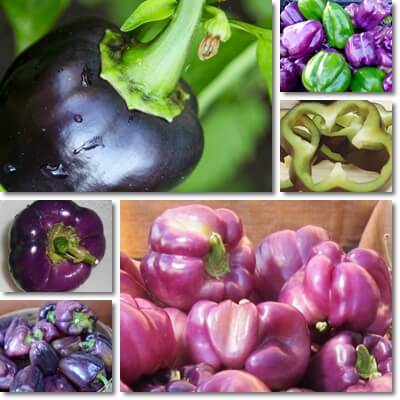Bell peppers or sweet peppers are known to ripen to different colors, depending on the cultivated variety. Ripe bell peppers are usually red, yellow, orange and even green, but they can also be a pale yellow, chocolate-colored or maroon, black, purple and even purple with yellowish stripes. Purple is actually a common color in peppers: there are purple jalapenos, chili, cayenne and even sweet purple bell peppers. Despite their striking color, purple bell peppers have a nutrition profile similar to their less remarkably-colored relatives, except for a few key nutrients, namely the color-giving compounds and a few essential vitamins such as vitamins C and K, and they provide roughly the same range of health benefits.
What are purple bell peppers?
Purple bell peppers are essentially sweet peppers that ripen to a purple color instead of the more common red, yellow or orange. Their scientific name is Capsicum annuum and they are a botanical fruit, but culinary vegetable. A key piece of information to remember about purple and other bell pepper colors is that, while they are all the same species, Capsicum annuum, they are different cultivated varieties, or cultivars, hence the different colors when ripening. In other words, purple bell peppers are not the same as red bell peppers which are not the same as green bell peppers which are not the same yellow or orange. Although they all start out green.

Purple vs black bell peppers
Technically, all bell pepper colors are obtained through artificial selection, meaning plants exhibiting particular traits (more specifically, fruit color) were selected and efforts were made to breed them. So purple bell peppers are a plant variety especially cultivated to produce purple-colored fruits. The fruits can be a lighter purple color, almost lavender, or a darker purple, almost black. Because nomenclature is still fuzzy, some consider black bell peppers to be a variety of purple bell peppers, just darker-colored. The fact is that both their colors come from anthocyanin antioxidant pigments. You can grow purple bell peppers from seeds or buy smaller plants (seedlings) at nurseries. They require the same conditions as other colors. Examples of purple bell pepper varieties include Purple Beauty, Purple Bell, Merlot and Lilac.
How to use purple bell peppers
I find it’s best to pick purple bell peppers when they’re ripe enough to have a pleasant taste, but young enough to retain a tender texture that allows you to eat them raw. Even though they may not have ripened to a uniform color. As for how to use them, know you can eat and cook them the same way as you would other colors. If young and tender, wash well, chop and add to fresh tomato, cucumber and onion salads with plain sunflower oil, or Mediterranean style salads such as a feta cheese, tomatoes, olives, extravirgin olive oil salad. Slice and eat raw with cheese cream, soft cheeses or other dips. If you like them cooked, there’s a myriad recipes you can incorporate them in.
One of my favorite recipes is stuffed purple bell peppers – depending on your diet and preferences, you can stuff them with meat or rice or even other vegetables. I also like them roasted or grilled, dipped in a thin crushed garlic, salt and water dressing. Another recipe I absolutely love is purple bell pepper risotto – a plain white rice risotto with chopped, oil-fried purple peppers. When it comes to recipes, your own imagination is the limit.

What do purple bell peppers look like?
They look like any other bell pepper, but with light or dark purple skin and green flesh (yes, the flesh is still green inside and only the skin is purple). Some varieties ripen from green straight to purple, either a lighter, lavender color or a darker, almost black color. Some start out lighter and darken with age. Others develop yellow stripes before fully ripening to purple. Also, not all fruits will develop a uniform color, but that has more to do with growing conditions than cultivar (health of the individual plant, weather conditions, amount of rainfall received, hours of sunlight and more). While the ideal pepper is one color throughout, don’t be surprised if you get two colors in one fruit. Of course, you could let the peppers ripen for as long as it takes for the color to become uniform, but that increases the chances of the fruit being attacked by insects or disease or even aging to the point it’s too tough to eat.
What do purple bell peppers taste like?
The taste of purple bell peppers depends on the cultivar and age of the fruit at harvest time. Ideally, the taste is sweeter than that of green bell peppers, but not as sweet as red, so somewhere in between, but crisp, fresh and overall fairly pleasant. If harvested too soon, they’ll taste bitter. If harvested too late, assuming they don’t spoil or get eaten by insects, they’ll become too tough to eat raw.
Nutrition facts
There is no official information available on the nutrition of purple bell peppers specifically (which is understandable seen that the cultivar is neither readily available, nor really a staple in modern diets). Whatever nutrition tables or other information you do find, know it’s all inferred from the available nutritional information of the more common green, red, yellow and orange bell peppers. For example, a serving of 100 g of the raw fruits is estimated to have a particularly low energetic value of only 20 kcal, owed to the low carbohydrate, sugar, fat and protein content (less than 5 g of carbs, around 2 g of sugar, and less than 0.5 g of fat and 1 g of protein). Dietary fiber content is estimated somewhere at 2 g per 100 g.
Purple bell peppers are believed to contain most, if not all of the essential nutrients found in other colors: vitamin A from antioxidants, vitamins B1, B2, B3, B5, B6, B9, choline, good amounts of vitamin C, small amounts of vitamin E (in the seeds mostly), vitamin K, calcium, copper, iron, magnesium, manganese, phosphorus, potassium and zinc. Exact amounts are currently undetermined, but presumed low for most B vitamins and vitamins A and E (a serving of 100 g of the raw fruit is estimated to provide up to 5% of the recommended daily intake of these essential nutrients). Purple bell peppers are expected to provide more generous amounts of vitamins C and K and overall good amounts of manganese and potassium, but no sodium. Content of other minerals is currently undetermined, but heavily dependent on soil quality (presence of minerals in soil available for uptake by the plant).
Antioxidant profile
Colors in fruits and vegetables and all plant life really are owed to pigmented antioxidant compounds. The following antioxidants can be found in purple bell peppers:
- Anthocyanins: concentrated in the purple skin.
- Chlorophyll: found mostly in the green flesh.
- Carotenes (in smaller amounts).
- Other polyphenols in the fruit and seeds.
- Antioxidant vitamins and minerals: vitamin C, vitamin E (concentrated in the seeds), copper, iron, manganese.
What are the benefits?
Potential benefits associated with consumption of purple bell peppers may include:
- Good food for healthy weight loss diets as it’s low in calories, fat and carbohydrates.
- Source of dietary fiber for relieving constipation.
- Rich in antioxidant anthocyanins and other polyphenols: antioxidants scavenge free radicals causing oxidative stress and thus help lower the risks of associated diseases such as certain cancers or chronic cardiovascular and metabolic diseases.
- Anti-inflammatory food: contains anti-inflammatory compounds such as anthocyanins, chlorophyll and other polyphenols and vitamins C and K.
- Benefits for the immune system from vitamin C and zinc, copper, iron and manganese which boost the immune system function.
- Benefits for skin from vitamin C which stimulates the production of collagen, a structural protein responsible for skin elasticity. Vitamin C is also an antioxidant with anti-aging effects for the skin.
- Other benefits for the skin from B vitamins which help reduce inflammation of the skin and vitamin E which protects skin from oxidative stress and helps it better retain moisture.
- Minor benefits for the brain and nervous system from B vitamins.
- Anti-anemia food: source of vitamin B6 for the synthesis of heme (a component of hemoglobin in red blood cells), vitamin B9 for the production of healthy red blood cells, and vitamin C for increasing iron absorption.
- Minor benefits for high blood pressure: having virtually no sodium, and providing small amounts of potassium and magnesium, it’s a good food to include in hypertension diets looking to lower blood pressure numbers.
What are the side effects?
The side effects of eating purple bell peppers include the potential for allergic reactions, although not as common as other food allergens, and gastrointestinal upset with symptoms such as indigestion, stomach discomfort and pain, bloating, burping, gas, heartburn and acid reflux. Purple bell peppers may act as a trigger food for acid reflux disease, or GERD, and gastritis, and should be avoided by anyone practicing an exclusion diet for the treatment of acid reflux disease and gastritis.
